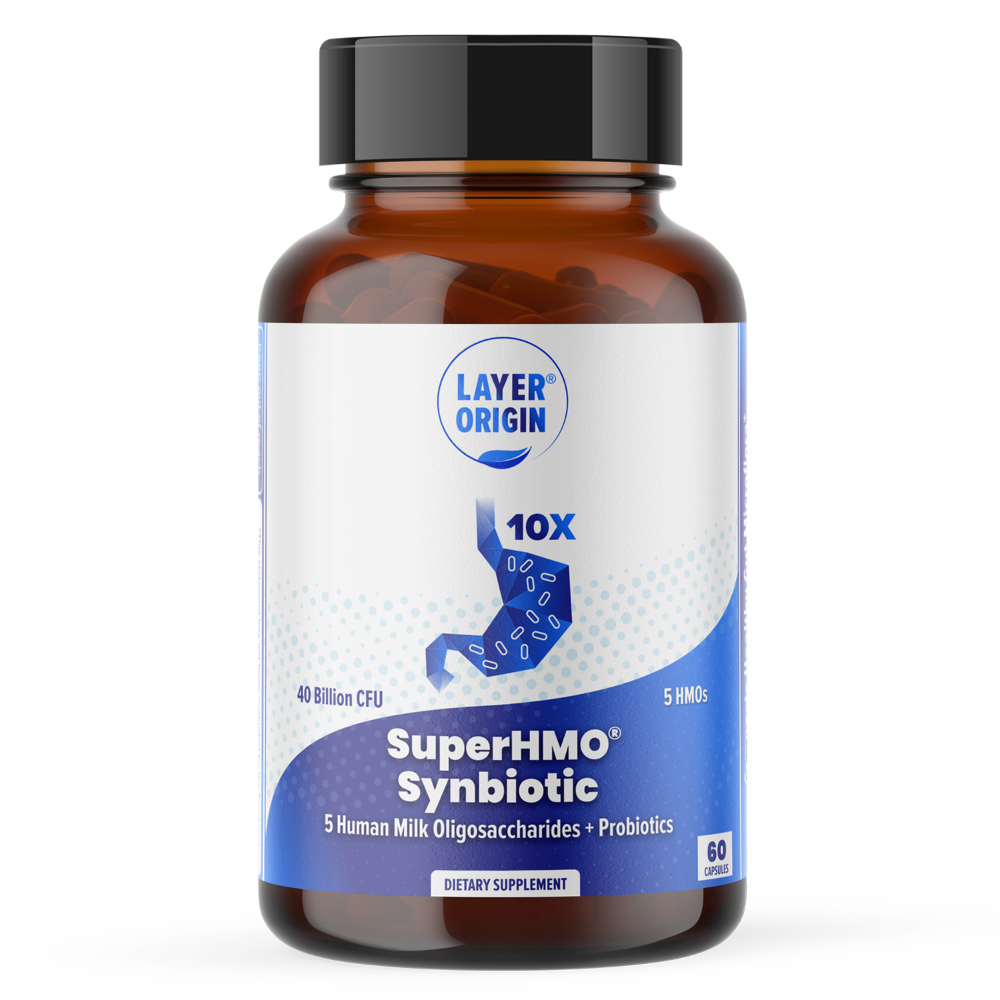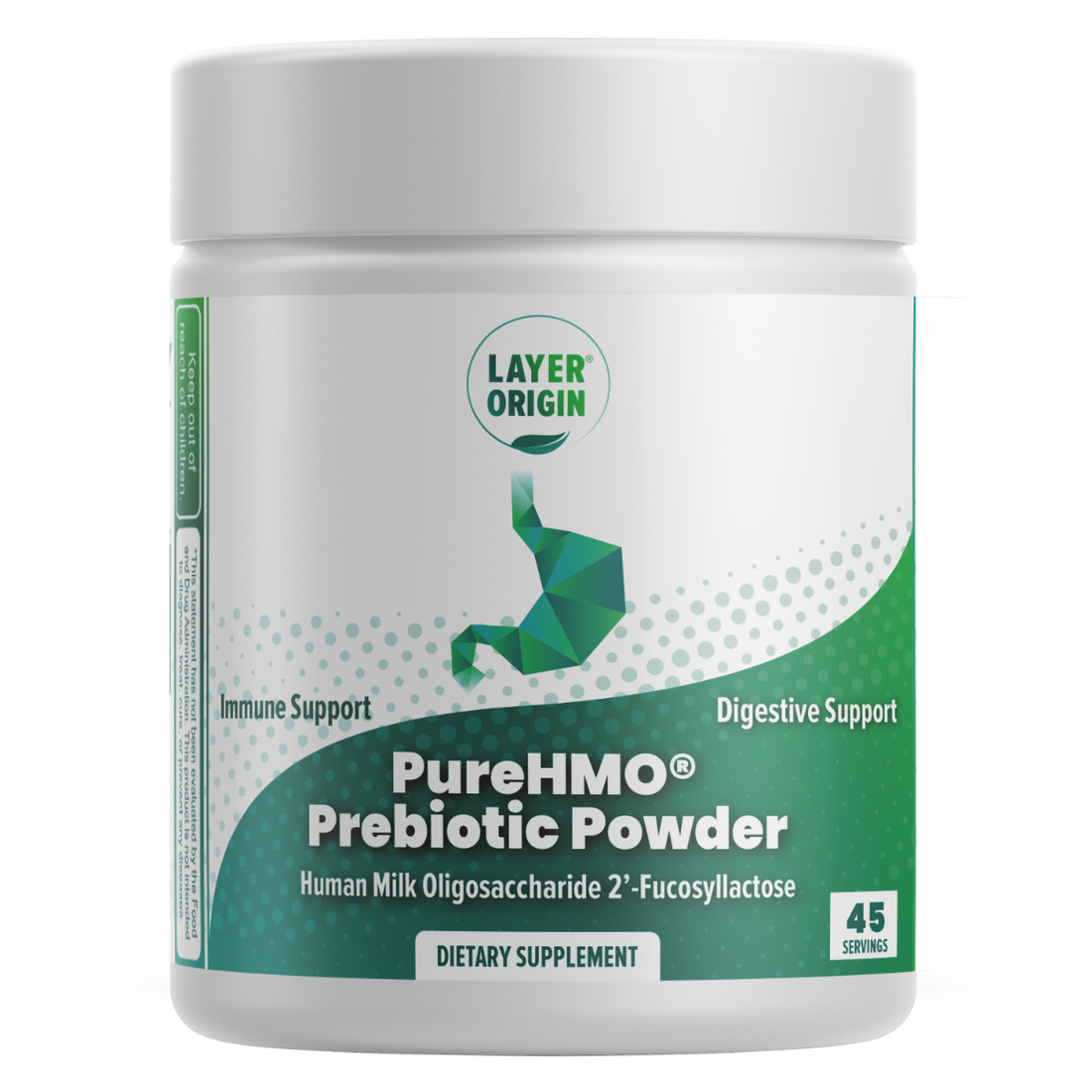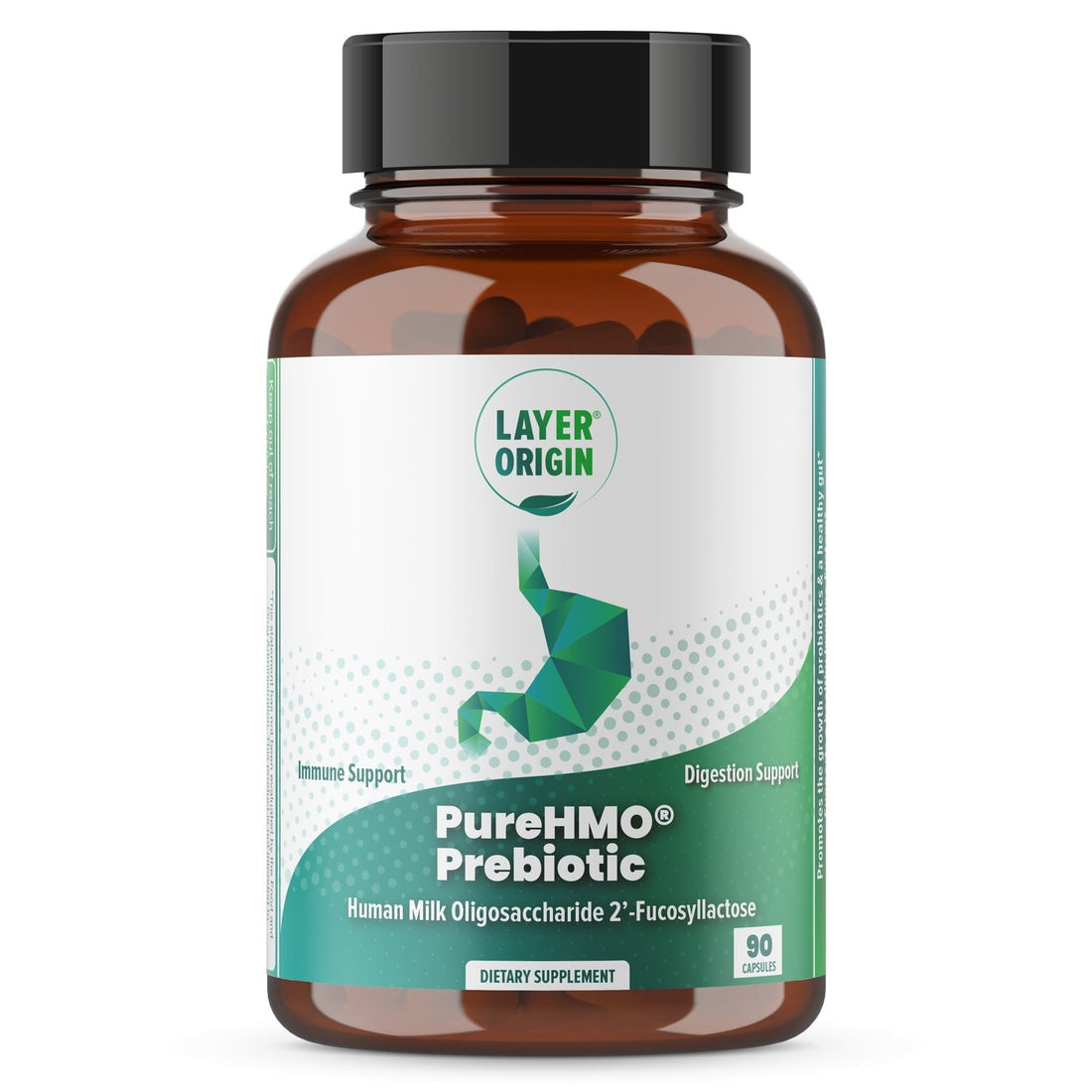2’-Fucosyllactose (2’-FL) is the most abundant human milk oligosaccharide (HMO) found in human breast milk. It’s renowned for the early development of the infant gut microbiome, particularly its effects on promoting the growth of Bifidobacteria. However, a recent study has revealed that the benefits of 2’-FL on the abundance and diversity of Bifidobacteria in the gut are age-dependent.
Content Outline
- Introduction: The positive benefits of 2’-FL
- Age-specific differences in Bifidobacterium species
- How was the study conducted?
- The bifidogenic effects of 2’-FL – What the research shows
- Conclusion
Introduction: The positive benefits of 2’-FL
More than 200 HMOs have been discovered and scientists are still trying to work out the functions of each one. Yet, we know that 2’-FL is one of the smallest HMOs in human breast milk, comprising just three molecules, but it’s also the most abundant[i].
One of the key roles of 2’-FL is to help establish the Bifidobacteria community in the infant gut because they are one of the first microbes to colonise the human gastrointestinal tract[ii]. Bifidobacteria are commensal microbes that happily live side by side with their human host, even carrying out functions that promote good health[iii].
In this article, we explore the results from a recent study published in Nutrients which has found the Bifidogenic effects of 2’-FL is age dependent. These results are important because reductions in Bifidobacteria are associated with an increased risk of illness in older adults.
Bifidobacteria over time
It has been well-publicised that the abundance of Bifidobacteria in the gut decreases with age. For example, they are one of the most abundant bacterial genera in the infant gut, but steadily decrease in adults, before declining again in old age (Figure 1)[iv].

Figure 1. Bifidobacteria levels through the ages. Bifidobacteria levels are at their highest at birth, particularly if you are born via vaginal birth. Levels then decrease during adulthood but remain relatively stable until declining again during old age. (Source: Arboleya et al (2016))
Interestingly, elderly people and centenarians have a marked reduction in Bifidobacteria abundance which may explain the increase in inflammaging and increased risk of chronic disease and mortality[v].
Age-specific differences in Bifidobacterium species
Kato and colleagues investigated the compositional changes of Bifidobacteria in the human gut across a wide range of ages, from 0 to 104 years in Japan in 2017.
Their results found:
- B. longum was detectable across all ages from newborns to centenarians
- B. breve was detected in 70% of children under 3 years old
- B. adolescentis and B. catenulatum were most dominant after weaning
- B. bifidum was found in almost all age groups
- B. dentium was highest in the elderly
- B. animalis ssp. lactis was found in 11.4% of subjects[vi]
Therefore, this research suggested differences in the abundance of Bifidobacteria species that occur with age.
Further research has shown that high levels of Bifidobacteria in the gut are linked to longevity and better health. However, low levels are seen in metabolic disorders, immune dysfunction[vii], and chronic conditions, like inflammatory bowel disease (IBD)[viii].
Even though age has been identified as a crucial factor that can impact the abundance of Bifidobacteria in the gut, not much is known about how these age-related differences may influence the microbial community’s response to a bifidogenic prebiotic like 2’-FL.That’s what Firrman and colleagues aimed to establish with their study. We’ll discuss their results next.
How was the study conducted?
The study involved 36 adults across six age groups (6 participants per age group):
- Breastfed infants (BF) (0 to 0.3 years)
- Toddlers (1 to 1.5 years)
- Children (5 to 7 years)
- Adults (25 to 35 years)
- Adults (35 to 50 years)
- Adults (50 to 70 years)
The fecal microbiomes for each adult were harvested and the responses of the microbial communities to treatment with 2’-FL, fructo-oligosaccharides (FOS), and lactose were analysed.
The bifidogenic effects of 2’-FL – What the research shows
To begin with, the research showed that each individual had a unique gut microbial community and that the communities clustered according to the age group. However, the breastfed infant and toddler groups had significantly distinct microbiomes compared to all other age groups. The children and older ages had similar compositions.
Interestingly, the most distinct difference in microbiota composition was the age-associated reduction in Bifidobacteria as age increased. There were also age-associated dominating Bifidobacteria species. For example:
Table 1: Bifidobacteria abundance and dominant Bifidobacteria species according to age.
|
Age group |
% of Bifidobacteria present in the gut |
Dominant species |
|
Breastfed infants |
100% (in 66% of breastfed infants guts) |
B. longum B. breve B. bifidum |
|
Toddlers |
<40% |
B. catenulatum B. pseudocatenulatum |
|
Children |
<10% |
B. catenulatum B. pseudocatenulatum |
|
Adults |
<10% |
B. adolescentis |
These structural differences and the decrease in Bifidobacteria are likely a result of several factors, including diet because the amount and types of food change with age[ix].
2’-FL promotes beneficial Bifidobacteria across all age groups
Next, the researchers analysed the effect of 2’-FL, the most abundant HMO with prebiotic qualities, on the composition of the human gut microbiome across all age groups.
It was found that 2’-FL supplementation increased Bifidobacteria levels across all age groups except the breastfed infants, probably because their gut bacterial community is already predominantly made up of this genus and they are already consuming HMOs in breast milk (Figure 2).
The results showed that the response to 2’-FL was mostly age-dependent. That’s because the age-dependent species shown in Table 1 increased according to their corresponding age group. Therefore, this demonstrates that 2’-FL exerts age-related bifidogenic effects. So, age determines which Bifidobacteria species are dominant in the gut and therefore directly influences which species respond to 2’-FL.

Figure 2. Absolute count at phylum level for the original fecal sample (INO), untreated (NSC), 2’-FL treatment (2’FL) per age group. Bifidobacteria belong to the phylum Actinomycetota shown in yellow.
The effect of 2’-FL on other commensal gut species
The beneficial effects of 2’-FL weren’t exclusive to Bifidobacteria, increases in other commensal species were observed. These microbial shifts also varied by age, and increased distinction between the microbial communities.
These changes were likely driven by cross-feeding. For example, previous research has highlighted how B. adolescentis, the dominant species in adults, cross-feeds butyrate producers such as Anaerobutyricum hallii[x] and Faecalibacterium prausnitzii[xi]. Interestingly, in this study, the link between B adolescentis, A. hallii, and butyrate was only observed in adults, despite being present in children, albeit in smaller numbers.
These results are important because they highlight how cross-feeding effects, and the impact of prebiotics, are age-dependent. Understanding these interactions is crucial because prebiotics can enhance specific bacteria while influencing the wider microbial networks in unpredictable and age-specific ways.
The effect of 2’-FL on SCFA production
Short-chain fatty acid (SCFA) production was increased across most age groups when 2’-FL was introduced, except in breastfed infants. Acetate strongly increased across all ages, suggesting that SCFA production was independent of microbiome differences.
Bifidobacterium likely produced acetate, whereas propionate and butyrate changes were variable, likely because of cross-feeding mechanisms.
Metabolic profiling using REIMS revealed age-specific metabolite patterns under normal conditions, but 2’FL treatment converged these differences, with less distinct differences between the communities in each age group. Therefore, confirming that the metabolites produced by the metabolism of 2’-FL aren’t necessarily age-dependent.
Overall, these results show that the composition of the gut microbiota is affected by age, which in turn, determined which bacterial taxa were increased because of 2’-FL. Yet, the metabolism of 2’-FL was similar across all age groups. In other words, the metabolic breakdown of 2’-FL is the same across the age groups, but the specific taxa that break down 2’-FL and those which benefit from the subsequent metabolites, are dependent on the microbiome composition.
Conclusion
2’-FL is the most abundant HMO and amongst its many benefits is its bifidogenic effect in the gut. The study results featured in this article demonstrate that age is an important determining factor when it comes to the effects of 2’-FL on the structure and composition of the human gut microbiome.
Interested in trying the bifidogenic effects of 2’-FL for yourself? Order yours here.
Written by: Leanne Edermaniger, M.Sc. Leanne is a professional science writer who specializes in human health and enjoys writing about all things related to the gut microbiome.
Sources
[i] [Internet]. Nature Publishing Group; [cited 2025 Feb 20]. Available from: https://www.nature.com/articles/d42473-018-00007-1#:~:text=Of%20all%20the%20HMOs%2C%20the,comprising%20just%20three%20molecules10.
[ii] O'Callaghan A, van Sinderen D. Bifidobacteria and Their Role as Members of the Human Gut Microbiota. Front Microbiol. 2016 Jun 15;7:925. doi: 10.3389/fmicb.2016.00925. PMID: 27379055; PMCID: PMC4908950.
[iii] Ruiz L, Bottacini F, Boinett CJ, Cain AK, O’Connell-Motherway M, Lawley TD, et al. The essential genomic landscape of the commensal bifidobacterium breve ucc2003. Scientific Reports. 2017 Jul 17;7(1). doi:10.1038/s41598-017-05795-y
[iv] Arboleya S, Watkins C, Stanton C, Ross RP. Gut Bifidobacteria Populations in Human Health and Aging. Front Microbiol. 2016 Aug 19;7:1204. doi: 10.3389/fmicb.2016.01204. PMID: 27594848; PMCID: PMC4990546.
[v] Ragonnaud E, Biragyn A. Gut microbiota as the key controllers of “healthy” aging of elderly people. Immunity & Ageing. 2021 Jan 5;18(1). doi:10.1186/s12979-020-00213-w
[vi] Kato K, Odamaki T, Mitsuyama E, Sugahara H, Xiao JZ, Osawa R. Age-Related Changes in the Composition of Gut Bifidobacterium Species. Curr Microbiol. 2017 Aug;74(8):987-995. doi: 10.1007/s00284-017-1272-4. Epub 2017 Jun 8. PMID: 28593350; PMCID: PMC5486783.
[vii] O'Neill I, Schofield Z, Hall LJ. Exploring the role of the microbiota member Bifidobacterium in modulating immune-linked diseases. Emerg Top Life Sci. 2017 Nov 30;1(4):333-349. doi: 10.1042/ETLS20170058. PMID: 33525778; PMCID: PMC7288987.
[viii] Iribarren C, Törnblom H, Aziz I, Magnusson MK, Sundin J, Vigsnaes LK, Amundsen ID, McConnell B, Seitzberg D, Öhman L, Simrén M. Human milk oligosaccharide supplementation in irritable bowel syndrome patients: A parallel, randomized, double-blind, placebo-controlled study. Neurogastroenterol Motil. 2020 Oct;32(10):e13920. doi: 10.1111/nmo.13920. Epub 2020 Jun 14. PMID: 32536023.
[ix] Salazar N, Arboleya S, Fernández-Navarro T, de Los Reyes-Gavilán CG, Gonzalez S, Gueimonde M. Age-Associated Changes in Gut Microbiota and Dietary Components Related with the Immune System in Adulthood and Old Age: A Cross-Sectional Study. Nutrients. 2019 Jul 31;11(8):1765. doi: 10.3390/nu11081765. PMID: 31370376; PMCID: PMC6722604.
[x] Belenguer A, Duncan SH, Calder AG, Holtrop G, Louis P, Lobley GE, Flint HJ. Two routes of metabolic cross-feeding between Bifidobacterium adolescentis and butyrate-producing anaerobes from the human gut. Appl Environ Microbiol. 2006 May;72(5):3593-9. doi: 10.1128/AEM.72.5.3593-3599.2006. PMID: 16672507; PMCID: PMC1472403.
[xi] Rios-Covian D, Gueimonde M, Duncan SH, Flint HJ, de los Reyes-Gavilan CG. Enhanced butyrate formation by cross-feeding between Faecalibacterium prausnitzii and Bifidobacterium adolescentis. FEMS Microbiol Lett. 2015 Nov;362(21):fnv176. doi: 10.1093/femsle/fnv176. Epub 2015 Sep 28. PMID: 26420851.








